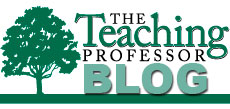I need to start out by saying that the article I’m writing about here isn’t for everyone. It’s not like any pedagogical piece I have ever read, and I’ve read quite a few. My colleague Linda Shadiow put me onto it, and although the article may not have universal appeal, the topic it addresses concerns faculty pretty much everywhere. How do we get students to pay attention? Their attention spans are short and move quickly between unrelated topics. Can we teach them how to pay attention? Is there value in trying to do so?
Author Anne McCray Sullivan, who was teaching in Florida when the article was published, writes, “My autobiography is largely an autobiography of attention—learning it, teaching it, discovering its role in research. It’s a story that began when I was very young.” (p. 212) Sullivan’s mother was a marine biologist who regularly took her daughter on outings to collect and study specimens. Sullivan did not follow in her mother’s footsteps. She’s a writer and a poet. The article includes nine of her poems, most of them describing her mother at work. The poems and article explore what Sullivan learned about attention, mostly from her mother. 
We pay attention at different levels—from sort of focusing on something to giving it full, undivided attention, an intensely focused concentration that obliterates all but the relevant details. I am a knitter, and I always try to have on my needles at least one complicated knitting project. Right now that happens to be a Cookie A sock pattern, done in the round on four very small needles. I tackle these projects first thing in the morning, when the coffee and I are fresh. I count stitches, inspect what I’ve done, move the markers, find mistakes, fix them, finish a round, and start the next one. It requires serious mental effort—the kind I hope will prevent Alzheimer’s. Suddenly my husband shows up. It’s time for breakfast, and my coffee is cold.
“My mother, the scientist, taught me to see. She taught me attention to the complexities of surface detail and also attention to what lies beneath those surfaces.” (p. 221) Sullivan writes that at the time she didn’t think she was paying much attention and she’s quite sure her mother thought the same. Her mother did try to teach her, sharing Latin names and scientific categories. “I remember very little of what she taught me in this direct way. What I do remember is so deeply embedded in experience that it has entered my ways of thinking and perceiving, my very way of being, without the intermediary of language—at any rate, without language that addressed this learning directly.” (p. 222)
One of the central questions explored in the piece is how teachers might help students discover the power that derives from attention that is all-consuming. We regularly teach material that students don’t see as interesting or relevant. Typically teachers try to solve the attention problem by tricking students, entertaining them, using bribes or coercion. Less often do we purposefully show what can be learned and experienced when serious attention is paid to something, really to anything. At this point, our content simply becomes the example.
We want students to share interest in what captivates our attention. We want them to fall in love with bugs, rocks, literary theories, religious paintings, differential equations, Ohm’s law, or countless other phenomena. And regularly we are disappointed by students’ complete lack of interest in, if not disdain for, these subjects that hold endless fascination for us. Maybe we need to be less idealistic and more realistic. The article made me wonder whether teaching students to pay attention might not be the more enduring lesson they could take from our courses. If our demonstration of how to attend to detail and how to study, analyze, question, pursue evidence, and untangle complexities might not be the more powerful gift, the one that will enable them to pursue to the depths whatever fascinates them.
I’ll let Sullivan have the last word. “She [her mother] taught me the rhythms of tide and regeneration, and the syllables of the natural world rubbing against each other. In doing so, she made me a poet.” (p. 221)
Reference: Sullivan, A. M. (2000). Notes from a marine biologist’s daughter: On the art and science of attention. Harvard Educational Review, 70 (2), 211-227.





